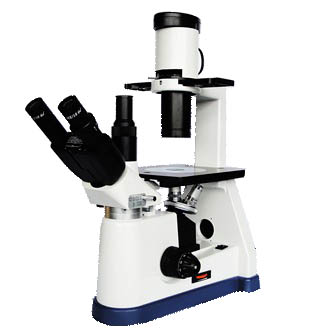
Difference Between Upright & Inverted Fluorescence Microscopes
Upright Fluorescence Microscopes
A fluorescence microscope's objectives and illuminating source are situated above the stage, allowing light to enter the specimen through an inverted pattern. This arrangement works best for slide viewing, especially with brightfield and fluorescence microscopes.
Key Features of Upright Fluorescence Microscopes:
- • Top-down Viewing: This part is also placed above the specimen, helping to view slides and thin sections.
- • Ease of Use: Uprights are plain and, most of the time, sufficient for beginner or teaching purposes.
- • Sample Preparation: Made especially for samples that one acquires from the fixatives and drops on a slide.
- • Field of View: This one is particularly suitable for preparing samples that are too thin and can even be transparent, and we can observe samples.
Inverted Fluorescence Microscope
On the other hand, the objectives and light source of the inverted fluorescence microscope are situated beneath the microscope stage. It helps observe live specimens, such as cells on culture dishes, healthy plates, or any vessel-holding culture, as it allows users to view specimens from below.
Principal characteristics of inverted fluorescent microscopes:
- • Bottom-up Viewing: These objective lenses are positioned below the specimen; this is most suitable to employ between the cells in an aqueous environment.
- • Live Cell Imaging: Live cell imaging is also done in inverted microscopes because its components can be replaced with other components of other types of inverted microscopes. They allow a much larger sample size, and the sample’s physiologic state remains intact.
- • Sample Flexibility: The samples of the significant variations and the sizes from the mere cell cultures and working tissue to the large specimens are described.
- • Ease of Access: This makes it easy for the observer to alter the samples under observation as needed.
To assess and compare fluorescence microscopes that are upright and inverted:
Choosing between the upright and inverted fluorescence microscope, all boils down to maintaining essential elements for a given research project. The upright fluorescence microscope is commonly used to observe fixed specimens using a slide and will be best used with thin samples. Other subtypes of fluorescence microscopes include the inverted fluorescence microscope used in live imaging and other structures viewed in natural conditions. Coslab India and many more suppliers are known to produce it.
Why Choose an Inverted Fluorescence Microscope from Coslab India?
Versatility:
Activated to various uses characteristic of microscopy, including live cell imaging, time-lapse observation and specimens under the current environment with liquids.
Precision:
The products are outfitted with high-quality optical systems, producing excellent-quality and accurate pictures.
Ease of Use:
It is designed to help the user take samples and, in the process of sample observation, try to control them.
Conclusion
In conclusion, considering the peculiarities of the scientific inquiry, it is possible to select between the upright or the inverted fluorescence microscope. Slide microscopy, also known as tissue culture microscopes, is an upright fluorescence microscope, and Coslab India provides imported inverted fluorescence microscopes for live cell imaging and other critical uses. When such differential microscope features are considered, a researcher will be better positioned to determine which type of microscope will most benefit his endeavors.

Top Uses And Benefits of Magnetic Stirrer With Hot Plate In Modern Labs
View More

Top Qualities That Define A Trusted Scientific Instruments Manufacturer
View More

A Complete Guide To Selecting The Best Lab Glassware Manufacturer in India
View More

Choosing The Right Lab Deep Freezer Manufacturers For Reliable Performance
View More
Subscribe To Our Newsletter
Stay in touch with us to get latest news and discount coupons

